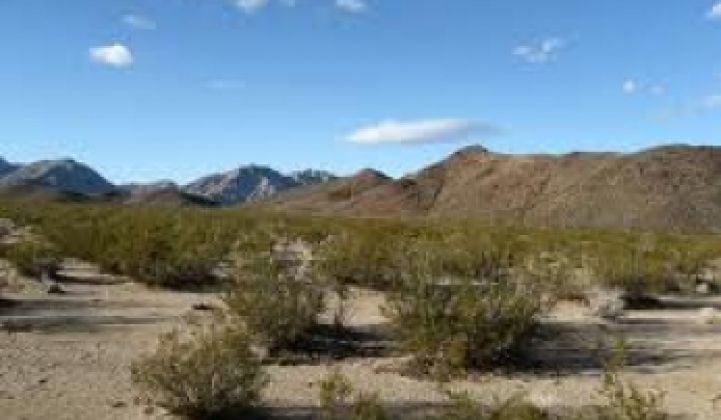Update: The California Energy Commission has approved the application of BrightSource Energy to build a solar thermal power plant in Ivanpah that, if it were complete now, would double the electricity coming from solar thermal plants in the U.S.
The Ivanpah project received a positive "proposed decision" from the California Energy Commission (CEC) back on August 4, and the CEC was expected to make a final decision today. The Bureau of Land Management still has to provide a final sign-off, but that's expected. BrightSource will likely have the construction permits it needs in the fall.
The CEC has recently approved Solar Millennium LLC's Blythe plant on Sept. 15, as well as Abengoa's Mojave Solar plant back on Sept. 8. More are expected next week and for the next several weeks. The CEC wants to make sure these plants get the necessary approvals in time to retain federal incentives granted earlier.
As part of the permitting process, Brightsource decided to resize the plant from 440 MW gross capacity down to 392 MW gross (370 MW net), in order to minimize the environmental impact, especially on the desert tortoise. That's the Ivanpah valley in the photo.
As shown in the Greentech Media CSP Project Tracker (click here to view), BrightSource's Ivanpah has already had their signed PPAs approved by the CPUC for the first 259 MW at Ivanpah. The PPA they signed with SCE for the last 133 MW is still awaiting approval. Ivanpah has already published its final EIS, and is awaiting a "final record of decision" from the BLM (expected around 10/6).
BrightSource received a conditional commitment for a Federal Loan Guarantee for $1.37B (section 1705).
Loan guarantees are limited to 80% of eligible project debt (with maximum debt to total project cost of 80%). So that means that the loan guarantee could at most cover 64% of the total project cost. Using $1.37B as 64% of the project cost, that would imply a total cost of $2.14B for 392 MW = $5.46/W-ac (that is watts AC, not DC, as is the case for PV plants).
Not a bargain compared to the $3.20/W-dc that First Solar is allegedly able to achieve, but OK when compared with the $5/W-ac that it will cost for the 1,000 MW parabolic trough plant at Blythe that Solar Millennium is building.
With an expected annual electricity generation of 1,172 GWh, that equates to a capacity factor of 34%, which compares quite favorably with PV at ~20% and trough at ~26%. BrightSource thinks the capacity factor should be about 30%. The end result is more kWh generated per watt of capacity installed, which means the levelized cost of electricity (LCOE) should be lower than would be predicted based on capital cost/W alone. At $5.46/W, and 30% capacity factor, Ivanpah should be producing power for a cost of about $0.17/kWh. That's still about two times as expensive as onshore wind, and about 40% more expensive than thin-film PV, which is currently the lowest cost solar option (at $0.12/kWh on an LCOE basis).
In related news, BrightSource also announced a new board chairman today. John Bryson, former chairman and CEO of Edison International, will lead the board going forward. Bryson is also involved with Coda, which wants to bring an Sino-American electric car to market.



